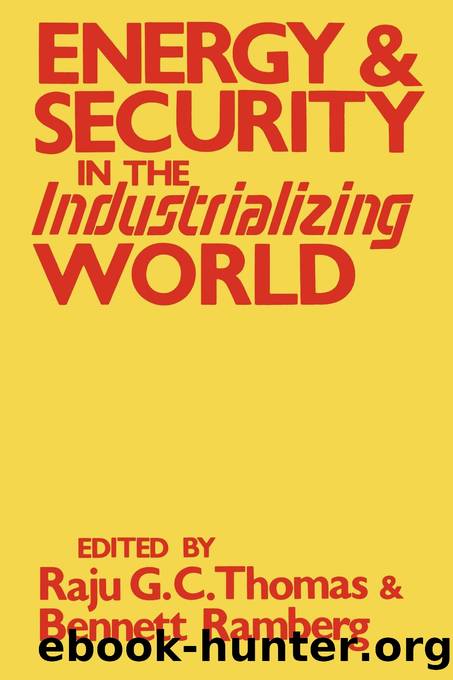Energy and Security in the Industrializing World by Raju G. C. Thomas & Bennett Ramberg

Author:Raju G. C. Thomas & Bennett Ramberg [Thomas, Raju G. C. & Ramberg, Bennett]
Language: eng
Format: epub
Tags: Political Science, Security (National & International), Technology & Engineering, Power Resources, General, Public Policy, Science & Technology Policy, International Relations
ISBN: 9780813155203
Google: uViLoAEACAAJ
Goodreads: 22618753
Publisher: University Press of Kentucky
Published: 2014-07-07T08:33:25+00:00
ENERGY IN ARGENTINA: THE EARLY YEARS THROUGH THE 1960S
Argentine petroleum deposits were discovered in the area around Comodoro Rivadavia in December 1907. The initial years of oil development saw Standard Oil of New Jersey, Royal Dutch Shell, and an Argentine company, Astra, working in relatively advantageous conditions, since the Argentine regime feared that its fuel supplies might be cut off by impending conflict in Europe.3 The problems of World War I mandated a national program for petroleum development. The national petroleum agency, Yacimientos Petroliferos Fiscales (YPF), was created in 1922 for the purpose of producing petroleum and related activities. Although YPF had government support, it was unable to make Argentina self-sufficient through the 1940s.4 Demand for petroleum rose at a higher rate than did production, particularly at the end of World War II, because of the dramatic rate of industrialization. From 1947 until 1955, petroleum imports climbed 100 percent to meet consumption, as YPF fell short of goals in increasing its domestic operations. The foreign corporations operating under contract with the YPF were prohibited from increasing their production levels, hence closing another method of holding down imports. YPF had not generated enough profits to invest in newer technologies and was allowing Argentina to fall behind its government-controlled petroleum production until 1940 while YPF increased refining of foreign companiesâ oil.5
Perón and his rhetorical concerns about national sovereignty had created domestic expectations that Argentina would be able to produce enough petroleum to meet its needs. By 1953, Perón had given way to economic realities and allowed foreign investment in the petroleum industry, but the damage had already been done. With Perónâs ouster in 1955, the national sentiment for sovereignty over domestic resources collided with the need for oil. Arturo Frondizi, a successor to Perón who charged that the Argentine people should retain control over their assests, had given YPF a legal monopoly over the production of petroleum by 1958.6 However, Argentina then had to buy 7 million barrels of crude oil from the Soviet Union while Frondizi attempted to entice private petroleum firms, some of them foreign, into production in Argentina. Buenos Aires signed drilling and development contracts with many private firms, including Esso, Royal Dutch Shell, Kerr-McGee, Astra Cia. Argentina de Petroleo, and Cia. Argentina para El Desarrollo de la Industria Petroleo y Minerales, SA.7 The need for increased energy production conflicted with the Argentine desire for national control over the means of production as well as profits. When Frondizi saw that YPF was unequal to the task of raising production, he turned to the private sector in a change of policy that was unpopular but that increased domestic production while drastically decreasing imports.
Beyond oil, the state became involved in other aspects of energy production. The government body Agua y EnergÃa took control over foreign holdings in electricity, while Gas del Estado, established in 1957, oversaw natural gas production.8 Even with growing state control, it was not until the latter 1960s that Argentines believed themselves on the way to self-sufficiency in various types of energy supplies.
Download
This site does not store any files on its server. We only index and link to content provided by other sites. Please contact the content providers to delete copyright contents if any and email us, we'll remove relevant links or contents immediately.
| Automotive | Engineering |
| Transportation |
Whiskies Galore by Ian Buxton(41566)
Introduction to Aircraft Design (Cambridge Aerospace Series) by John P. Fielding(32910)
Small Unmanned Fixed-wing Aircraft Design by Andrew J. Keane Andras Sobester James P. Scanlan & András Sóbester & James P. Scanlan(32589)
Craft Beer for the Homebrewer by Michael Agnew(17957)
Turbulence by E. J. Noyes(7741)
The Complete Stick Figure Physics Tutorials by Allen Sarah(7162)
Kaplan MCAT General Chemistry Review by Kaplan(6632)
The Thirst by Nesbo Jo(6482)
Bad Blood by John Carreyrou(6297)
Modelling of Convective Heat and Mass Transfer in Rotating Flows by Igor V. Shevchuk(6245)
Learning SQL by Alan Beaulieu(6057)
Weapons of Math Destruction by Cathy O'Neil(5876)
Man-made Catastrophes and Risk Information Concealment by Dmitry Chernov & Didier Sornette(5691)
Digital Minimalism by Cal Newport;(5419)
Life 3.0: Being Human in the Age of Artificial Intelligence by Tegmark Max(5215)
iGen by Jean M. Twenge(5193)
Secrets of Antigravity Propulsion: Tesla, UFOs, and Classified Aerospace Technology by Ph.D. Paul A. Laviolette(5086)
Design of Trajectory Optimization Approach for Space Maneuver Vehicle Skip Entry Problems by Runqi Chai & Al Savvaris & Antonios Tsourdos & Senchun Chai(4860)
Electronic Devices & Circuits by Jacob Millman & Christos C. Halkias(4770)
